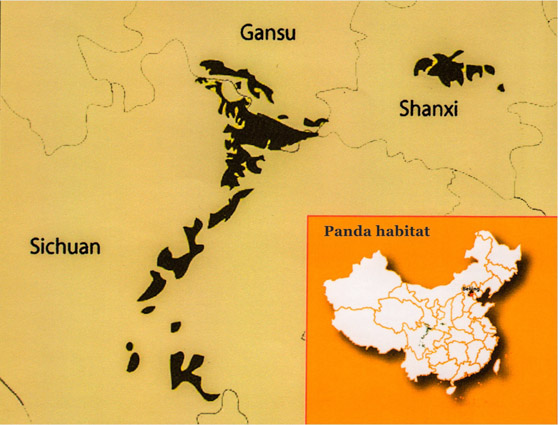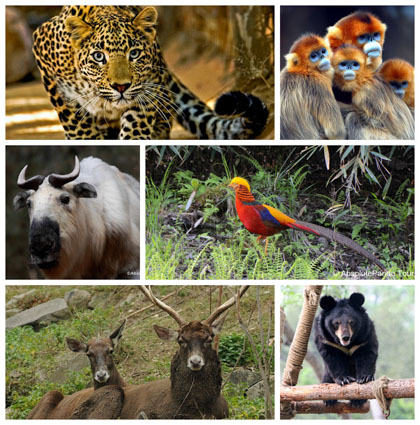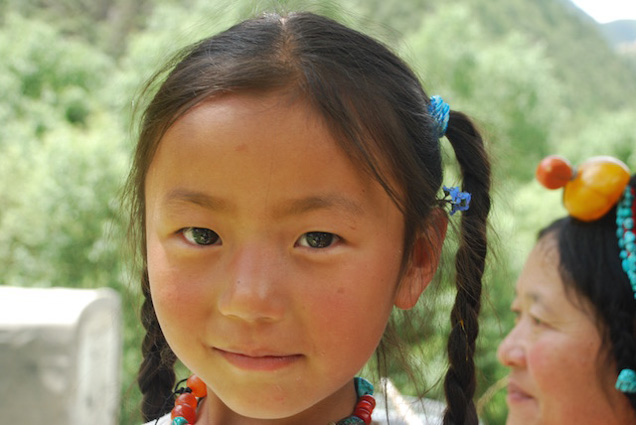Panda Habitat
The giant panda lives in a few mountain ranges in western China, mainly in Sichuan province, but also in neighbouring provinces, namely Shaanxi and Gansu.
Panda's habitat

The human footprint is very large in the mountains where giant pandas survive today. Conservation practice has taught us that effective conservation of biodiversity must meet the complex and diverse needs of both wildlife and people. China’s panda reserves play a central role. There are 55 panda reserves in China. Wolong national nature reserve is the best studied of the region’s protected areas. It also falls into the World Wildlife Fund’s Global 200 list of priority ecoregions. In some nature reserves like Tangjiahe nature reserve, Laohegou nature reserve and Jiuzhaigou nature reserve, there are also opportunities to track panda in their habitat.
Panda’s companion animals
Companion animals of Giant panda

The giant panda’s remote habitat is also home to a spectacular array of plants and animals, many of them are threatened by the same forces as the panda. Conservationists refer to giant pandas as an “umbrella species”. This means that the species’ home ranges are large enough, that setting aside an area large enough for its long-term survival will automatically protect other species that live under its umbrella. Under the panda’s umbrella lives some species who are officially listed as “rare and precious” by the Chinese government such as Takin, golden snub-nosed monkey, golden pheasants and Thorold’s deer, Leopards, cloud leopards and Asiatic black bears are also among the species that may live in panda habitat. Join our China wildlife safari, you will have the chance to track these animals and meet them out in the wild.
Local people
Not only these wild animals, human beings also share the same habitat with them. Most of the people who live close to giant pandas are minority groups. They are basically farmers living in the villages in the nature reserves. The principal threats to giant panda reserves are firewood collecting, logging, gathering forest products such as mushrooms, poaching, agriculture, grazing and mining. To secure a future for giant pandas, conservation actions must be adaptable, relevant and made socially acceptable by linking the welfare of pandas to that of people who live near them. A better future for all of us lies in establishing sustainable relationships between people and resources.

A Tibetan little girl
Developing sustainable tourism in this area is also an alternative for local communities. Tourism based on wildlife and minority culture under the concept of sustainability is a win-win strategy for both local and nature. We also want to be a part of the conservation of wildlife and help with the local communities. We designed trips visiting nature reserves and minority communities to discover the life of nature creatures and local people. Please find more information in our China wildlife safari and China minority culture tour.

The human footprint is very large in the mountains where giant pandas survive today. Conservation practice has taught us that effective conservation of biodiversity must meet the complex and diverse needs of both wildlife and people. China’s panda reserves play a central role. There are 55 panda reserves in China. Wolong national nature reserve is the best studied of the region’s protected areas. It also falls into the World Wildlife Fund’s Global 200 list of priority ecoregions. In some nature reserves like Tangjiahe nature reserve, Laohegou nature reserve and Jiuzhaigou nature reserve, there are also opportunities to track panda in their habitat.
Panda’s companion animals
Companion animals of Giant panda

The giant panda’s remote habitat is also home to a spectacular array of plants and animals, many of them are threatened by the same forces as the panda. Conservationists refer to giant pandas as an “umbrella species”. This means that the species’ home ranges are large enough, that setting aside an area large enough for its long-term survival will automatically protect other species that live under its umbrella. Under the panda’s umbrella lives some species who are officially listed as “rare and precious” by the Chinese government such as Takin, golden snub-nosed monkey, golden pheasants and Thorold’s deer, Leopards, cloud leopards and Asiatic black bears are also among the species that may live in panda habitat. Join our China wildlife safari, you will have the chance to track these animals and meet them out in the wild.
Local people
Not only these wild animals, human beings also share the same habitat with them. Most of the people who live close to giant pandas are minority groups. They are basically farmers living in the villages in the nature reserves. The principal threats to giant panda reserves are firewood collecting, logging, gathering forest products such as mushrooms, poaching, agriculture, grazing and mining. To secure a future for giant pandas, conservation actions must be adaptable, relevant and made socially acceptable by linking the welfare of pandas to that of people who live near them. A better future for all of us lies in establishing sustainable relationships between people and resources.

A Tibetan little girl
Developing sustainable tourism in this area is also an alternative for local communities. Tourism based on wildlife and minority culture under the concept of sustainability is a win-win strategy for both local and nature. We also want to be a part of the conservation of wildlife and help with the local communities. We designed trips visiting nature reserves and minority communities to discover the life of nature creatures and local people. Please find more information in our China wildlife safari and China minority culture tour.
Last one: Into the home town of Giant Panda ---Wolong
Next one: 10 Interesting Facts about Giant Panda
 info@absolutepanda.com
info@absolutepanda.com






